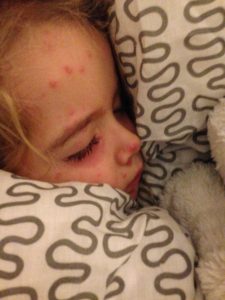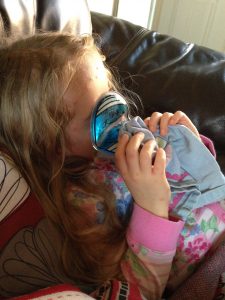 Chickenpox is a common childhood illness that most children catch at some point in their lives. It’s more common under the age of 10 years old, so it’s likely you’ll experience the delights of this illness during the nursery and primary school years.
Chickenpox is a common childhood illness that most children catch at some point in their lives. It’s more common under the age of 10 years old, so it’s likely you’ll experience the delights of this illness during the nursery and primary school years.
Although its considered to be a mild illness, you can expect your child to feel pretty poorly and miserable during their chickenpox days. My two little ones had quite a nasty case and it was a troublesome few weeks recovery, especially for my little girl who even got them on the bottoms of her feet and palms of her hands.
Do I need to see a doctor?
There is no need to see your *GP if you recognise the signs and spots of Chickenpox unless you feel your child is very unwell. If you see signs of infected spots, an unusually high temperature or difficulty breathing, then contact your GP right away.
What are the symptoms of Chicken Pox?
- Temperature
- A rash of red, itchy spots that quickly turn into fluid-filled blisters. They look unpleasant and can cause lots of discomfort to little ones.
- Lack of appetite, tires, grouchy and generally unwell.
What do I do about the spots?
Some children have only a few spots but some unlucky poppets get them all over body and sometimes in not-so-nice places. The original blisters eventually crust over to form scabs which eventually drop off.
Chickenpox spots are most likely to appear on the face, ears and scalp, under the arms, on the chest and stomach and on the arms and legs, but occasionally they can be found inside the ear, genitals and up the nose!
Is my child contagious?
Yes! Very! You may be surprised to know that Chickenpox is most infectious from one to two days before the rash starts – this is how it manages to spread around schools and nurseries so fast! Your little one will also be contagious until all the blisters have crusted over (usually five to six days after the start of the rash.
If your little one has Chickenpox try to:
- Prevent spreading the infection by keeping them off nursery or school until ALL the spots have crusted over.
- Keep them away from public areas to avoid contact with people who have not had it, especially people who are at risk of serious problems, such as newborn babies, pregnant women and anyone with a weakened immune system (for example, people having cancer treatment or taking steroid tablets).
How can I treat Chickenpox?
There is no specific treatment for chickenpox, but there are lots of tips and advice available (some of which you’ll get even if you don’t ask for it!)
During my career I’ve been through many bouts of Chickenpox with little ones and have to say a bove all other treatments I’ve found sudocrem works wonders, combined with (if they are old enough to have it) Piriton to which reduces swelling and irritation.Virasoothe is a wonderful soothing gel too – and really helps with the irritation that Chickenpox brings.
bove all other treatments I’ve found sudocrem works wonders, combined with (if they are old enough to have it) Piriton to which reduces swelling and irritation.Virasoothe is a wonderful soothing gel too – and really helps with the irritation that Chickenpox brings.
It’s worth trying a cool compress for super troublesome spots – we have a ‘Mr Bump’ cooling pad that we keep in the fridge for bumps and bangs and it helped our two lots during the super itchy days.
You can give your child infant paracetemol if they have a high temperature – but avoid using child nurofen/ibuprofen as there is a very small risk linked to causing adverse skin reactions during chickenpox.
My top tips for Chickenpox:
- Keep nails short
- Dress your little one in soft clothes (cotton p.J’s are great!)
- Use non-drying lotions and creams (Sudocrem is fab!)
- There are many pharmacy remedies which can alleviate symptoms, such as infant paracetamol to relieve fever and lotions, creams and cooling gels to ease the horrid itching – give them all a try to find what works best for your child! (Remember every child is different!)
- Some home remedies (an oatmeal bath) work – but all littlies are different, so its really just trying and seeing which makes your little one the most comfortable.
- Contact your GP straight away if your child develops any abnormal symptoms, for example: if the blisters on their skin become infected or if your child has a pain in their chest or has difficulty breathing.
Unfortunately as with any illness, routines go out of the window so avoid any sleep training techniques and give lots of love, cuddles when needed.
Finally, as with the majority of common childhood illnesses, try not to worry – as you can see from the smiley faces in the last pictures, recovery happens and they’ll soon be back to their old selves!








